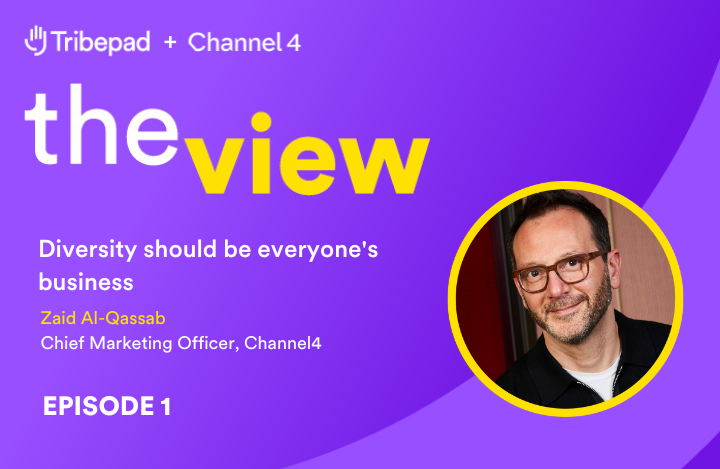A trailblazer in diversity, Channel 4 have a long history of amplifying underrepresented experiences, stories, and voices. Central to this mission is their emphasis on building an inclusive culture, with the vision “to be a beacon to the UK industry of what an inclusive, diverse and creative culture can look like”.
In our very first episode of The View – Tribepad’s new series sharing expert advice from the world of recruitment, HR, and marketing – we’re joined by Zaid Al-Qassab, CMO for Channel 4, and passionate diversity sponsor.
Catch up on-demand here or keep reading for our key takeaways from the session.
Progress starts with good diversity data…
“Do you set diversity and inclusion objectives?” Zaid asks. “Do you track them? Do you publish the results? And do you hold managers accountable? If not, it’s not surprising if you don’t make progress”.
If you can’t drill into your data to visualise diversity insights at every stage, it’s hard to know how you’re doing. Let alone where you need to focus to do better.
- Are you attracting diverse candidates?
- How do they progress through hiring?
- Do diverse employees get promoted?
- When do they leave the organisation?
When you can answer those questions, you know where to focus to improve. Or where to investigate more.
If you can see you’re losing Black female representation in leadership, for instance, you can ask why. And you can develop programmes and policies tailored to solving those issues.
What about when candidates choose not to disclose protected characteristics?
“That tells you something in its own right”, Zaid points out. “People tend to be willing to disclose information when they feel it’s a safe place to do so.” In its own way, then, if you’re struggling to collect the data you need, you have a good start point. How could you help candidates feel safer sharing?”
…but diversity is only the start
Improving diversity is only the first part of the challenge. We’ve seen in our research that many companies have made great strides on improving representation – helped by diversity-centric recruitment technology that removes unconscious bias and makes processes more inclusive.
- But do diverse hires stay with your organisation?
- Are they empowered to thrive?
- Do they feel supported and included?
Zaid captures the difference between diversity and inclusion beautifully as being a movement from facts to feelings:
You can measure around the room where people are from and such. The different characteristics that make them diverse.
But you can’t look around the room and instantly see how someone’s feeling inside. Whether they’re engaged; whether they feel safe and supported; whether they’ll go the extra mile for the company.
These things matter – but lots of companies are blind to the fact that how their employees feel is a huge driver of success.
Zaid shared five practical ways the Channel 4 team build an inclusive culture.
5 practical ideas to build an inclusive culture
1 – Encourage employee-led change
Employee resource groups (ERGs) or employee networks based around diverse characteristics or interests are a brilliant way of making people feel comfortable and included.
ERGs are a central part of how Channel 4 creates an inclusive culture, providing a safe space for employees to connect with other people who champion the same things.
“Most of our ideas to improve inclusion come from our ERGs”, Zaid says. “They’re an instant source of ideas and spotting possible issues, that we can then endorse and support with. If you’ve got your ear to the ground with ERGs as well as reporting, you’ve got a ready-made feed of things to improve.”
2 – Offer inclusion passports
Many organisations already use disability passports to help them make adjustments for employees with disabilities.
Channel 4 wanted to broaden this out, to recognise and accommodate the many ways employees might want to feel included beyond disabilities. Even beyond ‘hard’ diversity characteristics. Someone might need a little more flexibility because they’ve got caring responsibilities, for instance.
The inclusion passport acts as a “little nudge” to ensure these conversations are happening. It provides that “formal moment for people to talk about these issues and endorses employees’ right to those conversations”.
For example, the BBC recently spoke about the importance of personalising employee support by generation. Menopause support versus support with student loans, for example. A thoughtful benefits strategy like this can boost employees’ intent to stay by 11% and raise their productive output by 12%, the report shares.
3 – Endorse from the top
Employee-led change still needs top-down endorsement, Zaid warns. Leaders absolutely must champion and support diversity and inclusion initiatives, to have any meaningful impact.
“It’s got to come from the top”, Zaid says. “People can sense how important things are to you, as an organisation. People can see who’s talking about this stuff. Is it the CEO, or is it one junior HR person working against the odds to make change happen?”
4 – Set transparent diversity goals
Objectives are a huge part of setting the diversity agenda from the top. Does your organisation set and track targets in a transparent way – and hold managers and leaders accountable?
Zaid says it’s about the message you send:
Everyone knows that companies have targets for revenue and profit and costs and all sorts of other things the company considers critical to overall health.
If diversity targets are included in that basket – even if you don’t always hit them, like any other target – it tells employees you’re taking diversity seriously. And on the contrary too. I think not having diversity targets is a huge red flag.
Organisations are often afraid of publishing targets in case the results aren’t favourable. But change starts with vulnerability like this. Not with burying our heads in the sand and hoping the conversation will go away.
5 – Normalise tough conversations
For Zaid, conversation is the critical component of change – particularly around mental health support. He shares his personal experience of having suffered with depression and anxiety for many years, but only recently feeling able to admit so in the workplace.
It’s bizarre. I don’t know anyone who doesn’t have personal experience or a family member or friend with mental health struggles, but in workplaces there’s been a complete lack of conversation. That needs to change. You can’t even begin to have empathy without having conversations first.
Zaid talks about spurring change through educating managers, helping them to broach difficult topics and encouraging them to show vulnerability themselves. As momentum starts to build, sharing becomes more normalised and stigma decreases.
Diversity should be everyone’s business
Diversity and inclusion aren’t just an ethical consideration – and we shouldn’t be embarrassed to say that, Zaid emphasises. There have been endless studies that prove the business impact of diversity, across all the metrics that matter.
Yes, building diverse and inclusive organisations is better for people – that’s what matters most. But it’s also better for businesses, the economy, and ultimately feeds back into improving our communities too.
Diversity should be everyone’s business because diversity is in everyone’s best interests.
Zaid Al-Qassab, CMO for Channel4, spoke to Tribepad’s Neil Armstrong for the very first episode of Tribepad’s The View – a new series bringing you expert advice from across the world of recruitment and HR. Catch up on-demand here.
Tribepad is the trusted tech ally to smart(er) recruiters everywhere. Combining ATS, CRM, Video Interviewing, and Onboarding, our talent acquisition software is a springboard for faster, fairer, better recruitment for everyone.
Trusted by organisations like the Tesco, NHS Professionals, and Subway, 25-million people in 16 languages use Tribepad.




